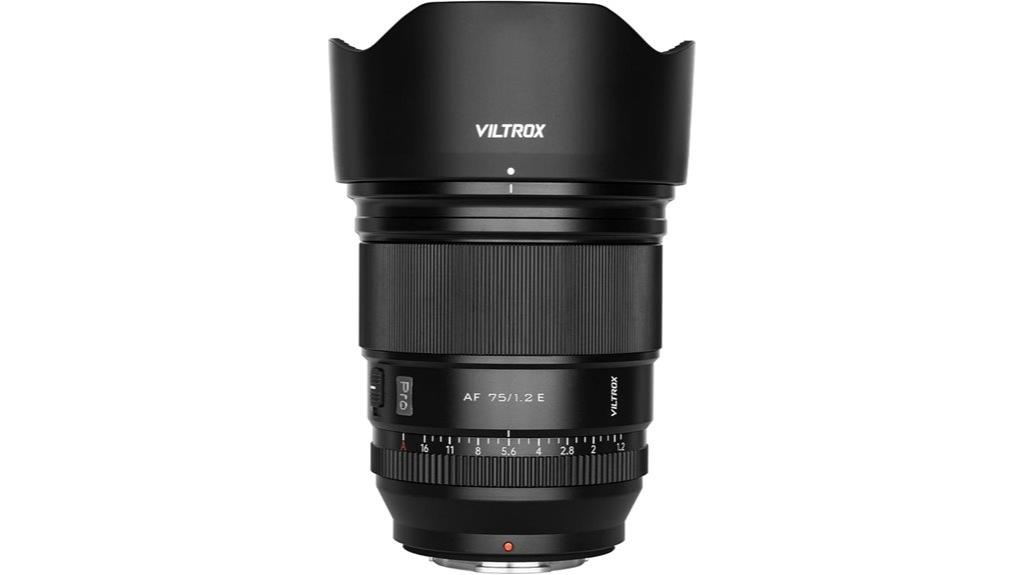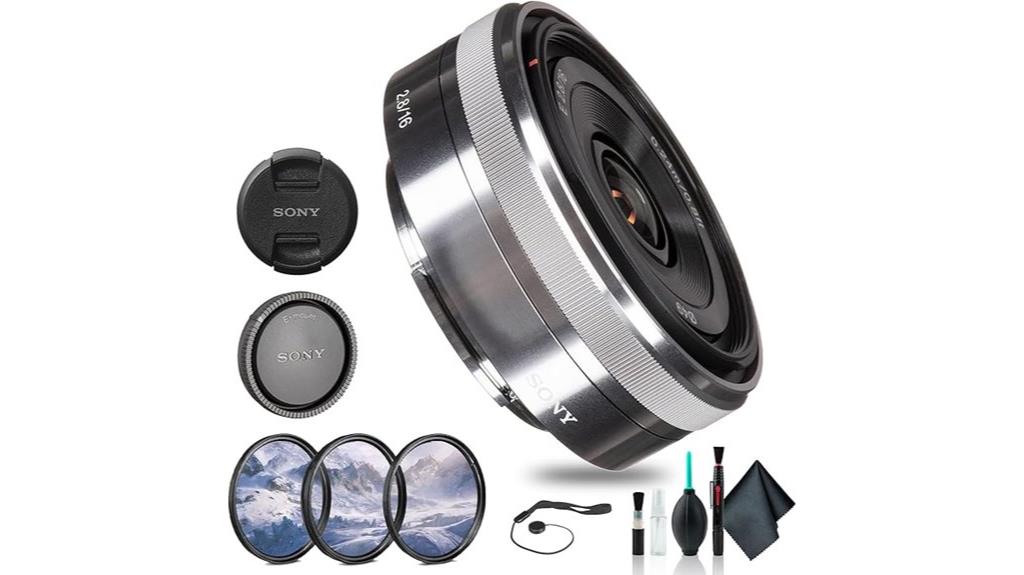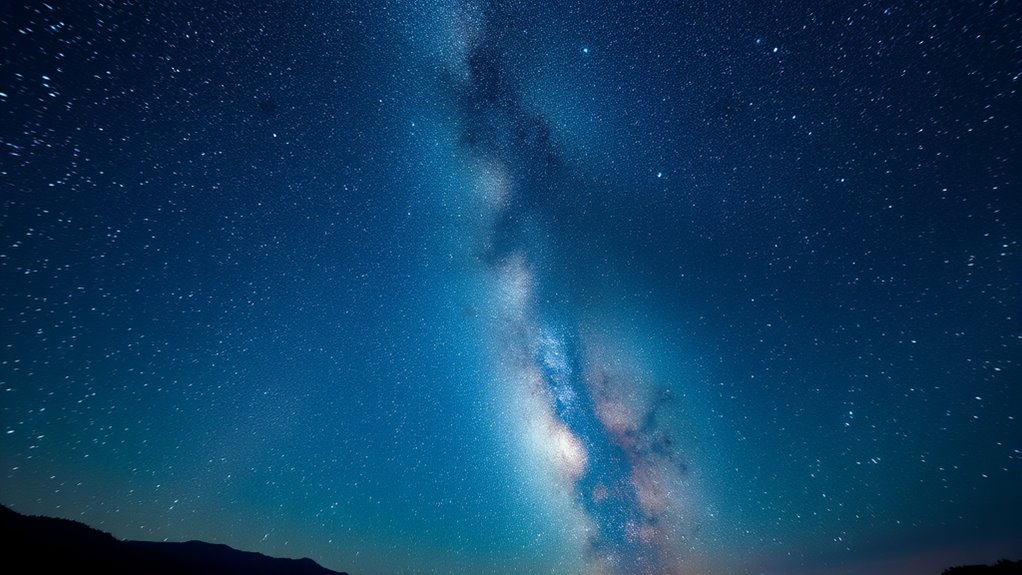If you’re after stunning Milky Way shots in 2025, I recommend considering wide-field lenses with large apertures, great optical quality, and broad coverage. The VILTROX 75mm f/1.2 lenses for Sony or Fuji are excellent for sharp, low-light images, while the AstrHori 6mm fisheye offers immersive views. The Sony E 16mm F2.8 is superb for lightweight portability. Want to discover the top picks and what makes them perfect? Keep exploring for all the details.
Key Takeaways
- Choose lenses with large apertures (f/1.4 or wider) for optimal low-light sensitivity and vibrant Milky Way detail.
- Prioritize ultra-wide angles (14mm–24mm) to maximize sky coverage and reduce stitching in wide-field shots.
- Opt for weather-sealed, lightweight lenses for durability and ease of outdoor night sky photography.
- Ensure minimal distortion and accurate focus mechanics to keep star trails sharp and horizons straight.
- Balance cost and optical quality, selecting lenses with high optical performance and good value for long-term astrophotography use.
VILTROX 75mm f/1.2 PRO E Lens for Sony APS-C Cameras

If you’re looking for a versatile lens that excels in low-light conditions, the VILTROX 75mm f/1.2 PRO E is an excellent choice for Milky Way photography, especially on Sony APS-C cameras. Its super large f/1.2 aperture allows more light to reach the sensor, enabling faster shutter speeds and lower ISO settings for sharper, clearer night shots. The lens features a robust all-metal build, fast autofocus, and dual aperture control, making it suitable for both photography and videography. While it’s a bit heavy, its high resolution and exceptional image quality make it a valuable tool for capturing stunning astrophotos.
Best For: photographers and videographers seeking a versatile, high-quality lens for low-light conditions, portraits, landscapes, and astrophotography on Sony APS-C mirrorless cameras.
Pros:
- Excellent low-light performance with a bright f/1.2 aperture, ideal for astrophotography and night shots
- Sharp, detailed images with superb resolution at wide apertures, suitable for professional-quality results
- Durable all-metal construction with fast, quiet autofocus, perfect for both photography and videography
Cons:
- Heavier and bulkier due to all-metal build, which may affect portability and handling
- No built-in image stabilization, relying on camera IBIS for stabilization during handheld shooting
- Large front element diameter requires specialized filters, which can be costly and harder to find
VILTROX 75mm f/1.2 XF PRO Lens for Fuji X Cameras

The VILTROX 75mm f/1.2 XF PRO lens stands out as an excellent choice for astrophotographers seeking sharp, detailed images of the Milky Way. Designed for Fuji X-mount APS-C cameras, it offers a large f/1.2 aperture perfect for low-light conditions. Its optical construction includes 16 elements in 11 groups, ensuring high resolution, vibrant colors, and minimal chromatic aberration. The autofocus is fast, quiet, and responsive, with manual override for precision. Built with durable metal, it’s lightweight yet sturdy. Its versatility makes it ideal for capturing stunning nightscapes, portraits, or landscapes, delivering excellent image quality at a competitive price point.
Best For: Amateur and professional astrophotographers, portrait, and landscape photographers seeking high-quality images in low-light conditions with a versatile, durable lens.
Pros:
- Large f/1.2 aperture excels in low-light and nightscape photography.
- Sharp optical performance with minimal chromatic aberration and vibrant color rendering.
- Fast, quiet autofocus with manual override, suitable for both photography and videography.
Cons:
- Slight chromatic aberration at high contrast scenes.
- Some users find the plastic parts feel cheap compared to the metal build.
- Heavier than standard lenses, which might impact handheld shooting comfort.
AstrHori 6mm F2.8 Circular Fisheye Lens for Nikon Z Mount

For astrophotographers seeking a truly immersive, artistic perspective of the night sky, the AstrHori 6mm F2.8 Circular Fisheye Lens for Nikon Z Mount stands out. Its 220° ultra-wide field of view surpasses human vision, creating bold, circular images perfect for capturing the Milky Way in a stunning, dramatic way. The large F2.8 aperture ensures bright, sharp images even in low light, making it ideal for night scenes and astrophotography. Built with a durable all-metal body, it’s compact and travel-friendly. Manual focus offers creative control, letting you fine-tune your shots for maximum artistic impact, whether landscapes, cityscapes, or VR content.
Best For: astrophotographers and creative artists seeking an ultra-wide, immersive fisheye perspective for night sky, landscape, and VR photography.
Pros:
- 220° ultra-wide field of view exceeding human vision for dramatic, immersive shots
- Large F2.8 aperture delivers bright, sharp images in low light conditions
- Durable all-metal construction combined with compact, travel-friendly design
Cons:
- Manual focus may require practice for precise adjustments
- Compatible only with Nikon Z mount full-frame mirrorless cameras, limiting versatility
- Requires user to set lens release manually; may need setup guidance from customer service
Sony E 16mm F2.8 Wide-Angle Prime Lens (SEL16F28)

With its compact design and bright F2.8 aperture, the Sony E 16mm F2.8 (SEL16F28) stands out as an ideal choice for astrophotographers seeking a lightweight, versatile lens. Its pancake-style build measures just 22.5 mm and weighs only 67 grams, making it perfect for travel and outdoor shoots. The lens features aspherical elements that minimize distortion and spherical aberrations, ensuring sharp, high-contrast images with natural colors. With a close focus of 0.24 meters and quiet autofocus, it handles both wide-angle landscapes and creative close-ups effortlessly. Compatibility with Sony conversion lenses adds to its flexibility, all without adding bulk to your kit.
Best For: photographers and videographers seeking a lightweight, versatile wide-angle lens for travel, street, landscape, and astrophotography with excellent image quality and portability.
Pros:
- Compact, pancake-style design weighing only 67g, ideal for travel and outdoor shooting
- Sharp, high-contrast images with natural colors thanks to aspherical elements
- Quiet autofocus and close focusing distance of 0.24 meters for creative wide-angle close-ups
Cons:
- Fixed focal length may limit versatility compared to zoom lenses
- No image stabilization, which could affect handheld shooting in low light
- Limited to APS-C E-mount cameras, restricting compatibility with full-frame Sony models
78 D Double Aspheric Lens

Looking for a lens that offers precise detail and clarity for eye examinations? The 78 D Double Aspheric Lens is an excellent choice. It combines an ideal field and magnification, making slit lamp exams more efficient. With a 78 diopter strength, it’s designed for detailed eye assessments and provides an extended working distance from the cornea. Its compact size—just under 3 inches and weighing only 5 ounces—makes it easy to handle. Rated 4.4 out of 5 stars, it’s popular among professionals. Manufactured by KASHSURG, it’s a reliable tool for clinical precision, with slight variations due to ongoing research and development.
Best For: professionals seeking precise, high-quality eye examination tools with extended working distance and excellent magnification.
Pros:
- Provides optimal field and magnification for detailed slit lamp examinations
- Extended working distance from the cornea enhances clinical efficiency
- Compact and lightweight design for easy handling and portability
Cons:
- Product specifications and color may vary slightly due to ongoing R&D
- Limited reviews (9) may not fully represent all user experiences
- Slightly higher price point compared to basic lenses
Factors to Consider When Choosing Wide-Field Lenses for Milky Way Photography

When selecting a wide-field lens for Milky Way photography, I consider factors like the field of view range and how wide it can capture the night sky. Aperture size is vital because a larger opening lets in more light, improving low-light performance. I also pay attention to lens distortion, focus accuracy, and speed to guarantee sharp, clear shots in dark conditions.
Field of View Range
A wide field of view (FOV) is essential for capturing stunning Milky Way images because it lets you include more of the night sky in a single shot. Ultra-wide lenses with focal lengths between 6mm and 20mm on full-frame cameras typically offer a FOV of 100° or more, perfect for astrophotography. The FOV depends on the lens’s focal length and the camera sensor size—smaller sensors usually produce a slightly narrower view at the same focal length. A broader FOV enhances the sense of scale and drama but can also introduce distortion, which you can fix later. Choosing a lens with a wide FOV means you cover more sky, minimizing the need for multiple shots or stitching, making your Milky Way photography more efficient and impressive.
Aperture Size Importance
The size of the aperture plays a crucial role in selecting a wide-field lens for Milky Way photography because it directly impacts how much light the camera can gather in low-light conditions. A larger aperture, like f/2.8 or wider, allows more light to reach the sensor, making it easier to capture the faint details of the Milky Way. It also enables shorter exposure times, reducing star trailing caused by Earth’s rotation. An aperture between f/1.4 and f/2.8 strikes a good balance between light collection and depth of field. Larger apertures help in capturing vibrant colors and subtle features without excessive ISO noise. However, they can introduce optical aberrations, so choosing high-quality lenses with well-corrected, large apertures is essential for sharp, detailed astrophotography.
Low-Light Performance
Considering low-light conditions, choosing a wide-field lens with excellent optical clarity and minimal aberrations is essential for capturing sharp, detailed images of the Milky Way. A lens with a large aperture, like f/2.8 or wider, lets in more light, making it easier to capture faint stars and nebulae without excessive ISO settings. High optical quality ensures sharper images and reduces chromatic aberration, which can distort star points. Good low-light performance also means less vignetting and distortion at wide apertures, resulting in even exposure across the frame. Additionally, fast autofocus and manual focus capabilities help achieve precise focus on distant celestial objects in dark skies. Overall, a lens optimized for low-light conditions enhances image clarity, reduces noise, and makes astrophotography more enjoyable and successful.
Lens Distortion Control
Since wide-field lenses with minimal distortion are essential for accurate Milky Way images, I pay close attention to optical design features that reduce curvature and warping. Lenses with low distortion prevent curved star trails and keep horizons straight, resulting in more natural, true-to-life images. To achieve this, many good options incorporate aspherical elements and specialized optics to maintain image integrity at wide apertures. Recognizing potential barrel or pincushion distortion is important, as correcting these during post-processing can vastly improve your astrophotos. Choosing lenses known for effective distortion control ensures sharper star fields and clearer celestial details. Ultimately, minimizing distortion helps you produce stunning, professional-looking Milky Way shots with accurately rendered skies and landscapes.
Focus Accuracy & Speed
Achieving sharp, detailed images of the Milky Way depends heavily on how quickly and accurately your lens can focus in low-light conditions. Precise focus is essential to keep stars and celestial details crisp, especially at wide apertures like f/1.2 or f/2.8. Fast autofocus systems with quick response times help lock focus swiftly, minimizing missed shots during fleeting night moments. When autofocus struggles, manual focus combined with focus peaking or live view magnification offers more control and precision. A lens with minimal focus breathing ensures tiny adjustments don’t shift your composition or focus plane unexpectedly. Consistent focus speed across different lighting and distances is critical to maintain sharpness across the vast star fields, making your astrophotography more reliable and rewarding.
Size & Portability
The size and portability of a wide-field lens are crucial factors that can greatly impact your astrophotography experience. Bigger lenses often have larger front elements, making them bulkier and harder to carry, especially during travel. Compact wide-angle lenses are much easier to handle and transport, which enhances mobility during outdoor shoots. Lighter lenses reduce fatigue during long sessions, whether you’re handholding your camera or using lightweight tripods. Travel-friendly lenses with smaller dimensions fit more easily into camera bags, making them ideal for on-the-go Milky Way photography. Overall, the size and weight of a lens influence how convenient setup is in remote locations, affecting your ability to quickly capture those perfect shots under starry skies. Choosing a portable lens helps ensure you’re ready for spontaneous night sky adventures.
Build Durability
Durability is a critical factor when selecting a wide-field lens for Milky Way photography, especially since outdoor conditions can be unpredictable. I look for lenses with all-metal construction, which offers better resistance to shocks and environmental stressors. Weather-sealed designs are essential, as they protect against dust, moisture, and temperature changes that can damage the internal components. Reinforced lens mounts and high-quality seals also contribute to longevity, making the lens more reliable during rugged outdoor shoots. A well-built lens can withstand frequent transport and handling, ensuring consistent performance over time. Choosing a model with sturdy materials and solid engineering minimizes the risk of damage, giving me confidence that my gear will perform reliably, session after session, no matter the conditions.
Price & Value
When selecting a wide-field lens for Milky Way photography, balancing price and value is key to getting the best results without overspending. Prices range from affordable options around $200 to premium models over $1000, so it’s important to contemplate what features offer the most bang for your buck. Lenses with larger apertures like f/1.4 or f/2.8 deliver better low-light performance but come at a higher cost, impacting value. Durability and build quality also play a role in long-term investment, especially for outdoor shoots. Comparing the price-to-performance ratio—such as autofocus, manual focus control, and lens coatings—helps ensure you’re choosing a lens that offers the best features for your budget, maximizing both quality and value.
Frequently Asked Questions
Which Wide-Field Lens Offers the Best Light Pollution Reduction?
The Rokinon 14mm f/2.8 Ultra-Wide Lens is my top choice for light pollution reduction. Its wide aperture captures more light, making it easier to shoot in darker skies, while its manual focus helps eliminate vibrations. I’ve found it effective at minimizing light pollution effects, especially when combined with proper location selection and post-processing. This lens gives me clearer, more detailed Milky Way shots even in less-than-ideal conditions.
How Does Lens Flare Impact Milky Way Night Shots?
Lens flare can feel like a unwanted spotlight on my Milky Way shots, washing out details and reducing contrast. It happens when bright light hits the lens elements at certain angles, scattering light inside and creating streaks or halos. To keep my night sky images sharp and clear, I avoid direct light sources, use lens hoods, and shoot with high-quality lenses that minimize flare. It’s like taming a wild horse for a cleaner shot.
Can I Use Crop Sensor Lenses for Astrophotography?
Yes, you can definitely use crop sensor lenses for astrophotography. I’ve found they’re great for capturing the night sky, especially when combined with a good wide-angle lens. The crop sensor’s crop factor effectively increases the focal length, giving you a tighter view of the Milky Way. Just make sure to choose a lens with a wide aperture, like f/2.8 or lower, to gather enough light for stunning shots.
What Is the Ideal Aperture for Capturing the Milky Way?
Coincidentally, the ideal aperture for capturing the Milky Way is around f/2.8 or wider. I’ve found that this setting allows enough light to reach the sensor, revealing stunning details without excessive noise. Opening the aperture wider, like f/1.8, can be even better if your lens allows, but f/2.8 strikes a perfect balance. Remember, a fast lens and high ISO settings also help in capturing those breathtaking night sky shots.
How Do Weather Conditions Affect Wide-Field Astrophotography Lenses?
Weather conditions greatly impact my wide-field astrophotography. Clear, dry nights with minimal humidity are ideal because they reduce haze and atmospheric distortion, giving me sharper images. Wind can shake my camera, so I prefer calm evenings. Cloud cover blocks the stars entirely, making shooting impossible, and light pollution washes out the Milky Way. I always check weather forecasts to guarantee ideal conditions before heading out for astrophotography.
Conclusion
Choosing the right wide-field lens is like finding the perfect window to the night sky—once you get it right, the Milky Way unfolds in all its glory. I remember switching to a wider lens and suddenly feeling like I was stepping into a cosmic painting. With the right gear, your photos can tell a story as breathtaking as the universe itself. So, trust your instincts, pick your lens, and let the night sky inspire you.









